Marine diesel engine checks
Like and Share
Marine diesel engines will give you thousands of hours of reliable service. However they need some regular love and maintenance in order to keep them behaving reliably. The following is not an exhaustive maintenance regime but rather a list of essential marine diesel engine checks to cover off before leaving the marina or anchorage.
Marine diesel engine checks
Marine diesel engine checks before each voyage are often overlooked, especially as we become more confident and complacent and wash over some of the routine. This is a trap that can catch out the most seasoned sailor. For this reason keeping a documented checklist for reference, ideally a laminated card, on the boat is a good idea.
Before marine diesel engine startup:
- Check coolant levels
- Pop off the cap and check the coolant or, if your coolant reservoir is clear, check the tank visually. A good idea is to mark the level with a magic marker and check against that if there is not a clear “max” line on the tank.
- Check floor of engine compartment
- It’s important to check the floor of the engine compartment for evidence of coolant, raw water or oil leaks.
- It’s also important to always clean and mop up any muck from the engine bay floor so that any new leaks can be easily identified. If, in an emergency, you have an unidentified liquid in the engine bay at sea you’re going to need to pop a little drop on your tongue (don’t swallow) to test if it’s salty (sea water), fresh (leaking water tank) or sweet (coolant) and having a clean engine bay makes this a little less unpleasant and will make it easier to diagnose the cause of the problem.
- Check engine oil level
- The level should be above the half way mark and NOT higher than the full line. Check the oil is black and NOT milky which would indicate water in the sump. If it is milky don’t leave the dock!
- Check gearbox oil
- Check levels are consistent with previous checks and between half and full mark.

- Eyeball the belt and check belt tension
- Check the belt is in good shape with no cracks or damage. Push with direct pressure at the longest point; ideally it should flex about two to three centimeters (1 inch) max. If the belt is too loose it could allow slippage and if it is too tight it can cause premature wear on the belt and components.
- Ensure the fuel supply tap is on
- If you have a fuel shut off tap fitted, check it’s set to the ON position.
- Check your fuel filters/water separators visually if you have clear inspection bowls fitted

- Check raw water sea cock is open
- Check your raw water strainer
- Open up and check your sea strainer for any muck obstructing the flow. Anything from seaweed to fish to jellyfish tentacles can end up in there, so take care with bare hands. If it looks suspect, grab some gloves.
- Eyeball the batteries
- Check for corrosion on the terminals and check charge level.
After marine diesel engine start up:
- Check raw water is coming from the exhaust
- You will get used to the volume of water you normally get from your exhaust so check that the flow fits your usual expectations.
- Check fuel levels
- Check that you have enough for your journey and plenty extra.
- Update log with start of journey engine hours
- For every journey, enter your engine hours at the start and at the end. This is useful for calculating your fuel consumption especially on longer passages, so you you can keep an eye on your liters/hour usage. If you start to burn more fuel than usual this is a good warning sign for further investigation.
- Visual check of engine and mounts
- Nuts and bolts have a habit of coming loose when you least expect them to. It’s a good idea to give the engine a once over visually while everything is running and vibrating as expected. Check your engine mounts and listen for any new rattles or sounds that are not familiar. Doing this each time you leave the dock will get you used to the sound of your engine, allowing you to quickly pick up on anything rattling loose or dripping where it should not be dripping.
- Engine warm up and monitor
- Let the engine warm up for a few minutes while you prep the boat and check in on coolant temp to ensure there is nothing out of the ordinary.
- Check oil pressure is up to the normal values. It is not a bad idea to note these characteristics in your log for later referral.



